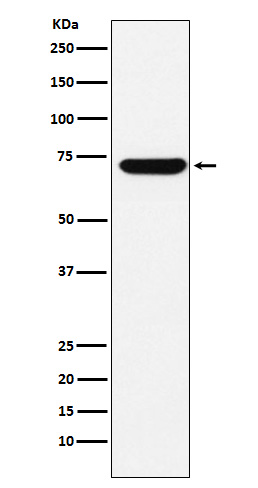ZBTB7A Rabbit mAb [cwGW]Cat NO.: A87218
Western blot(SDS PAGE) analysis of extracts from HepG2 cell lysate.Using ZBTB7A Rabbit mAb [cwGW]at dilution of 1:1000 incubated at 4℃ over night.
Product information
Protein names :FBI1; LRF; Pokemon; TIP21; ZBTB7; ZBTB7A; ZNF857A;
UniProtID :O95365
MASS(da) :61,439
MW(kDa) :70kDa
Form :Liquid
Purification :Affinity-chromatography
Host :Rabbit
Isotype : IgG
sensitivity :Endogenous
Reactivity :Human
- ApplicationDilution
- 免疫印迹(WB)1:1000-2000
- 免疫组化(IHC)1:100
- 免疫荧光(ICC/IF)1:100
- The optimal dilutions should be determined by the end user
Specificity :Antibody is produced by immunizing animals with A synthesized peptide derived from human ZBTB7A
Storage :Antibody store in 10 mM PBS, 0.5mg/ml BSA, 50% glycerol. Shipped at 4°C. Store at-20°C or -80°C. Products are valid for one natural year of receipt.Avoid repeated freeze / thaw cycles.
WB Positive detected :HepG2 cell lysate.
Function : Transcription factor that represses the transcription of a wide range of genes involved in cell proliferation and differentiation (PubMed:14701838, PubMed:17595526, PubMed:20812024, PubMed:25514493, PubMed:26455326, PubMed:26816381). Directly and specifically binds to the consensus sequence 5'-[GA][CA]GACCCCCCCCC-3' and represses transcription both by regulating the organization of chromatin and through the direct recruitment of transcription factors to gene regulatory regions (PubMed:12004059, PubMed:17595526, PubMed:20812024, PubMed:25514493, PubMed:26816381). Negatively regulates SMAD4 transcriptional activity in the TGF-beta signaling pathway through these two mechanisms (PubMed:25514493). That is, recruits the chromatin regulator HDAC1 to the SMAD4-DNA complex and in parallel prevents the recruitment of the transcriptional activators CREBBP and EP300 (PubMed:25514493). Collaborates with transcription factors like RELA to modify the accessibility of gene transcription regulatory regions to secondary transcription factors (By similarity). Also directly interacts with transcription factors like SP1 to prevent their binding to DNA (PubMed:12004059). Functions as an androgen receptor/AR transcriptional corepressor by recruiting NCOR1 and NCOR2 to the androgen response elements/ARE on target genes (PubMed:20812024). Thereby, negatively regulates androgen receptor signaling and androgen-induced cell proliferation (PubMed:20812024). Involved in the switch between fetal and adult globin expression during erythroid cells maturation (PubMed:26816381). Through its interaction with the NuRD complex regulates chromatin at the fetal globin genes to repress their transcription (PubMed:26816381). Specifically represses the transcription of the tumor suppressor ARF isoform from the CDKN2A gene (By similarity). Efficiently abrogates E2F1-dependent CDKN2A transactivation (By similarity). Regulates chondrogenesis through the transcriptional repression of specific genes via a mechanism that also requires histone deacetylation (By similarity). Regulates cell proliferation through the transcriptional regulation of genes involved in glycolysis (PubMed:26455326). Involved in adipogenesis through the regulation of genes involved in adipocyte differentiation (PubMed:14701838). Plays a key role in the differentiation of lymphoid progenitors into B and T lineages (By similarity). Promotes differentiation towards the B lineage by inhibiting the T-cell instructive Notch signaling pathway through the specific transcriptional repression of Notch downstream target genes (By similarity). Also regulates osteoclast differentiation (By similarity). May also play a role, independently of its transcriptional activity, in double-strand break repair via classical non-homologous end joining/cNHEJ (By similarity). Recruited to double-strand break sites on damage DNA, interacts with the DNA-dependent protein kinase complex and directly regulates its stability and activity in DNA repair (By similarity). May also modulate the splicing activity of KHDRBS1 toward BCL2L1 in a mechanism which is histone deacetylase-dependent and thereby negatively regulates the pro-apoptotic effect of KHDRBS1 (PubMed:24514149)..
Tissue specificity :Widely expressed (PubMed:9927193). In normal thymus, expressed in medullary epithelial cells and Hassle's corpuscles (at protein level) (PubMed:15662416). In tonsil, expressed in squamous epithelium and germinal center lymphocytes (at protein level) (PubMed:15662416). Up-regulated in a subset of lymphomas, as well as in a subset of breast, lung, colon, prostate and bladder carcinomas (at protein level) (PubMed:15662416). Expressed in adipose tissues (PubMed:14701838)..
Subcellular locationi :Nucleus.
IMPORTANT: For western blots, incubate membrane with diluted primary antibody in 1% w/v BSA, 1X TBST at 4°C overnight.


